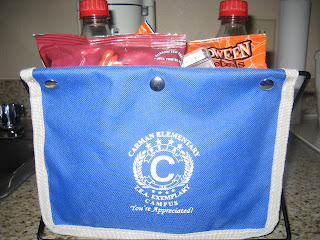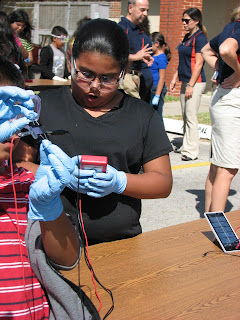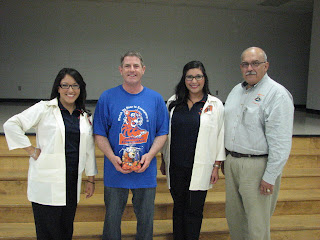 |
| Saturday's trek from El Paso to San Antonio: A Long Day's Journey into Night. |
Saturday morning October 1 brought with it the feat of driving the Project iLASER van across the desolate plains and hillsides of west Texas, from El Paso to San Antonio (about 550 miles or so). The conclusion of Sunday's journey found me in the
Rio Grande Valley in McAllen (point B on the map below) - a casual weekend jaunt of approximately
800 miles. I'm now a relative stone's throw from the Project iLASER finish line in Harlingen (point C on the map below) a mere 35 miles to the east.
 |
| Closing in on the Gulf of Mexico. |
The first 65 miles or so of Interstate 10, eastbound out of El Paso, hug the border. It's a curious contrast of serene green with unusual concrete. Namely, Garden of Eden-esque scenes to the south, where the water from the Rio Grande obviously keeps immediately neighboring vegetation very vivid, contrast the myriad of paved ramps that lead from the shoulder of the interstate into the desert trails north of the river. It's obvious those ramps are used to permit easy access to the Border Patrol vehicles that incessantly monitor those trails and the terrain surrounding them. I've lived in southern CA, for more than two decades now, a relatively short distance from the U.S.-Mexico border and have never seen ramps like that.
Those several hours spent driving through west Texas on Saturday were relatively devoid of communication, which isn't necessarily a bad thing. Cell phone coverage was sparse, and for a great distance the only radio broadcasts I was able to receive were college football, country music and Rush Limbaugh. Don't get me wrong, I am a fan of college football and was very pleased to hear the scoreboard report to learn that the
University of Illinois Fighting Illini (my
alma mater) defeated the Wildcats of Northwestern University 38-35 in the Big Ten season opening game, improving their overall season record to 5-0.
Further, while the cell phone coverage was thin on the road,
the rest areas in Texas guarantee cell phone coverage, and some have wireless internet. Well, in addition to the usual reasons one stops at a rest area, I stopped into a rest area somewhere in Pecos County to check the score in game 1 of the
National League Division Series between
my St. Louis Cardinals and the
Philadelphia Phillies. I learned that
Lance Berkman had hit a three-run home run in the 1st inning to give the Cardinals a great start to a game played in Philadelphia. However, the Phillies ultimately came back to win game 1 with a score of 11-6, although the Cards won last night's game 5-4 to tie the series, which moves to St. Louis for game 3 tomorrow.
Even though the Cardinals ultimately lost game 1, it would have been wonderful to experience a greater bandwidth of radio to enjoy across west Texas, including the baseball broadcast. Unfortunately that wasn't the case, and country music and Rush Limbaugh really don't do anything for me, although I am in no way criticizing or condemning anyone for whom such sensory stimuli are pleasing. More power to ya!
Sorry for the random ramblings. The blogging is giving me a chance to decompress after the
exhausting weekend journey and before I head into a lab later today at
South Texas College (STC), thanks to the kind hospitality of STC chemist Dr. Ludivina (Ludy) Avila, to prepare another batch of electrodes used for children here in The Valley to construct dye-sensitized solar cells. Ludy is also a firm believer in the importance of science outreach and enrichment activities for children and young adults. She runs a great
Science Olympiad here in The Valley and also advises the very successful
STC Student Chapter of the American Chemical Society.
On to recent Project iLASER events...
Excitement in El Paso
Three clubs comprise the
Boys & Girls Clubs of El Paso:
Club Delta,
Club Janacek and
Club Petty. I can't begin to put into words the great things Mr. Arturo Jaime and his excellent staff are doing for the children of El Paso through the endeavors of the Boys & Girls Clubs. I'm very impressed by the level of community engagement and impact on the children they're having.
An event was held Thursday September 29 at Club Delta and another was held at Club Janacek on Friday September 30. On Tuesday October 11, during my return trip to Chula Vista, a Project iLASER event will be held at Club Petty. For now, I'm going to allow the photos below to speak for me. They undoubtedly ramble less than I do!
Loads of Fun at Club Delta
 |
| There's
Maribel Morales, Director of Club Delta, holding the schedule for the
Club's activities, including the special Project iLASER event. Maribel
does a great job with the Club's members. |
 |
| That's Addis on the far right. She was one of my assistants for this event and really has a lot of talent and passion for science. She's showing some of her younger Club members how blocking the laser light stops the music. |
 |
| Can you say "Solar-Powered Excitement!"? |
 |
| There was no shortage of energy in THIS room! |
 |
| There's Addis taking a leadership role, once again, demonstrating how to dye the titanium dioxide with blackberry juice. |
 |
| These two teams of solar scientists compared the performances of the solar cells they built. |
 |
| It was getting late in the day, with the sun sinking low in the sky. New experiment: Will holding the solar cells closer to the sun increase the output of electricity? [smile] |
Miles of Smiles at Club Janacek
 |
| The crew at Club Janacek were enthused about the prospect of powering the planet with sunlight. |
 |
| That's Evelyn and Jesús working together to rearrange the atoms in models of water molecules. |
 |
| The investigation of light, color and vision was a big hit at Club Janacek. |
 |
| These children were really having a great time exploring the solar-hydrogen activities. |
 |
| There was never a lull in the action! |
 |
| The solar energy stored in the hydrogen was used to power the LEDs. |
 |
| Serious solar-hydrogen sustainable energy research was obviously happening here! |
 |
Hey! Look at OUR measurement!
|
 |
| Yep, that's a four year old working that multimeter. |
 |
| It's obvious how proud and inspired she is to share her experimental outcome. Excellent job, young lady! |






























































